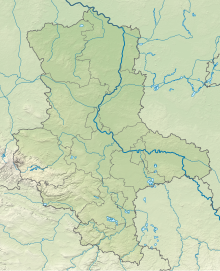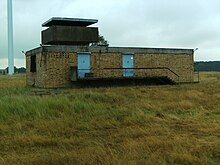Transmitter castle
|
Transmitter castle
|
|||||||||||||||||
|---|---|---|---|---|---|---|---|---|---|---|---|---|---|---|---|---|---|
| Basic data | |||||||||||||||||
| Place: | Castle | ||||||||||||||||
| Country: | Saxony-Anhalt | ||||||||||||||||
| Country: | Germany | ||||||||||||||||
| Altitude : | 42 m above sea level NHN | ||||||||||||||||
| Coordinates: 52 ° 17 ′ 13.2 ″ N , 11 ° 53 ′ 49.2 ″ E | |||||||||||||||||
| Use: | Radio ripple control technology , radio | ||||||||||||||||
| Accessibility: | Transmission system not accessible to the public | ||||||||||||||||
| Owner : | Media broadcast | ||||||||||||||||
| Data on the transmission system | |||||||||||||||||
|
|||||||||||||||||
| Wavebands : | LW stations , MW stations | ||||||||||||||||
| Radio : | MW broadcasting | ||||||||||||||||
| Send type: | Directional radio | ||||||||||||||||
| Position map | |||||||||||||||||
|
|
|||||||||||||||||
The Burg transmitter from Media Broadcast for broadcasting in the long and medium wave range is located in the Brehm district of Burg (near Magdeburg) . The two most striking structures of this complex are a 324 meter high guyed steel truss mast and a 210 meter high guyed tubular mast.
The 324 meter high former mast for long wave is no longer used for radio today. It is a grounded construction with a triangular cross-section and carried a highly effective shrinkage-reducing transmitting antenna in the form of a special trap antenna developed in the Soviet Union , which was called the ARRT antenna , until the beginning of the 1990s . It served to DDR -times the on the frequency 783 kHz-driven 1000 kW medium-wave transmitter , which the strongest transmitter of the GDR was, as a transmitting antenna. This fish trap antenna was dismantled in the early 1990s. In the second half of the 1990s, the transmission mast received a trap antenna for long waves on the frequency of 261 kHz, which was used to broadcast the Radioropa Info program until 2000 . Today it is used to broadcast the frequency 139 kHz of the transmitter DCF 39, a radio service operated by the Europäische Funk-Rundsteuerung GmbH (EFR) for the remote control of electrical consumers such as street lamps. A resumption of broadcasting on the long wave frequency of 261 kHz in DRM mode is planned.
The steel framework mast is one of the seven tallest structures in Germany. At the time of its completion in 1953 it was the tallest building in the GDR and also the tallest in all of Germany (GDR and Federal Republic). Even today it is the tallest structure in Saxony-Anhalt.
At some distance from the 210-meter tubular mast that still exists today, there was a second mast of the same size, which was blown up in 2006. Both 210 meter high tubular masts are or were isolated from the earth . One of the two tubular masts could be used as a base- fed self-radiating transmission mast for long and medium wave, while the other transmission mast could only be used for the medium wave range.
As further antenna systems there are three steep -beam antennas, each suspended from two free-standing steel lattice towers and serving as a transmitting antenna for a medium-wave transmitter on the frequency 1575 kHz, which is currently shut down, as well as a triangular antenna for medium wave.
From 1967 to 1976, this system also included a 350-meter-high transmission mast for long waves, the SL3 tubular steel lattice mast for broadcasting Radio Volga programs . In order not to influence the radiation field of the other masts, this transmitter mast was located 2.2 kilometers from the other masts on the road from Burg to Grabow , near the Gütter district of Burger . It collapsed on February 18, 1976 because of a broken bolt and was not rebuilt. However, there are still some remains of the anchoring foundations and the voting house (coordinates: 52 ° 16 ′ 9 ″ N , 11 ° 55 ′ 24 ″ E ). At the former base of the transmitter mast, the fencing of which is still completely preserved, there is now a private wind turbine . As a replacement, one of the two 210-meter-high tubular steel masts was converted so that it could also broadcast the program of Radio Volga and the Voice of Russia (later also from Radioropa Info) in the long wave range.
On June 22, 2006, one of the two 210-meter tubular masts was brought down with targeted explosive charges. As the reason for the removal, the “ Volksstimme ” published in Magdeburg cites its missing condition, which, according to T-Systems , would have required a reconstruction costing around 800,000 euros. However, a future need for this mast could not be proven. The operator has rented the remaining 210-meter mast for broadcasting the German program of Voice of Russia.
On August 17, 1956, the German freedom transmitter 904 on 904 kHz (later 908 kHz) went on air from here. The program, which was initially produced in East Berlin and from the mid-1960s in Bestensee near Königs Wusterhausen , was broadcast in the evenings from 8 p.m. to 9 p.m. and from 10 p.m. to 11 p.m. On September 30, 1971, broadcasting was stopped due to the looming policy of détente . In addition, there was the overthrow of Walter Ulbricht, a great advocate of the KPD, by Erich Honecker on May 3, 1971 and the transfer of Max Reimann, the long-time KPD chairman, to the DKP, which was newly founded in 1968, on September 27, 1971, i.e. four days before sending. Probably not by chance, on October 1, 1971, by resolution of the State Broadcasting Committee of the GDR, the former German broadcaster was merged with Berliner Welle to create the new Voice of the GDR program .
From October 1960 to June 1972 the German soldier transmitter 935 , which was produced in Berlin-Grünau , also addressed the members of the Bundeswehr on 935 kHz . He used the same 250 kW medium wave transmitter as the German freedom transmitter 904 . So they never broadcast at the same time. Because of the necessary frequency resetting work, the transmission and transmission start of the two transmitters usually differed by 15 minutes.
On February 25, 2014, a triangular antenna made of three 50-meter-high transmission masts, which was located directly next to the transmission mast that was blown up in 2006, was blown up.
See also
Web links
- Central mast castle. In: Structurae
- Cane masts castle. In: Structurae
- Tubular steel lattice mast SL3. In: Structurae
- Castle I- Mast , published at http://www.waniewski.de/
- Castle K- Antenne , published at http://www.waniewski.de/
- Information about the former long wave transmitter Burg 261 kHz ( Memento from May 22, 2009 in the Internet Archive )
- http://www.senderfotos-bb.de/burgmw.htm
- https://www.youtube.com/watch?v=_9MSB3xrL9o Video of the detonation of the triangular antenna




